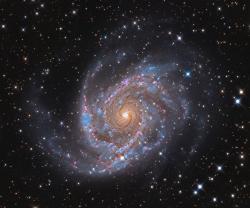
Howdy, Stranger!
It looks like you're new here. If you want to get involved, click one of these buttons!
BlockHead
About
- Username
- BlockHead
- Joined
- Visits
- 257
- Last Active
- Roles
- Member, Administrator
Comments
-
Just specify "L" I believe. Unstretched? Do you have some screenshots?-the Blockhead
-
Well... like any of the stellar photometry tools... it depends on the data and the GAIA catalog. What were you taking a picture of....?What color band...?How many stars in the picture...?What is the FWHM... ?Did you platesolve *with* PI? etc etc e…
-
It is just the name of the all-sky survey of reference images that the new Multiscale Gradient Correction process uses. MARS = "The Multiscale All-Sky Reference Survey " . Of course the 5 minute answer is in my video on the subject. These reference…
-
Perhaps this is a good little project for someone to jump on?Technically I have the data to show change of color. I would need to make color pictures of each triad I have. But my exposures are 600 seconds long. I would think triads of 30 second expo…
-
Likely not...the eclipse takes place over many exposures. But keep in mind that the stars are also different temperatures... one is certainly bluish and the other very likely reddish. There will certainly be a change of color throughout the eclipses…
-
Hi Mike, I considered this demo a "repeat" of the WR 134 example (which has the data). I am just demonstrating again the techniques on different objects. I can certainly make the masters available. However... it may have to wait for the new website.…
-
There is a Search magnifier icon at the top right of the screen in most browsers. (It is next to the Login/Logou button). If you are viewing on a small screen (phone)- it may be different. -the Blockhead
-
No. (it did not for me...works just fine)-the Blockhead
-
Exactly... you did it correctly. You can use a binary mask... in combination and it will give you what you want. But, you can't control the amount of star-like objects. It was worth a shot though. You can do what you originally described for great …
-
At the time I made the video... most of the market WAS just CCD!I think you will like the NB course. Lots of good stuff in there. -the Blockhead
-
I think your idea is on the right track. Using MLT can certainly pick up on star-like structures. You can also try the GAME script in one go. You can make an ellipse around the galaxy and see what GAME pickup up for "stars" within the ellipse.Use th…
-
CMOS and CCD cameras are different. I would expect the CMOS sensor to have more variation from pixel to pixel since the pixels each have electronics controlling things. With CCD..it was more the substrate itself. So I would not compare the sensor I …
-
Yes, I will refund the difference to your card on file.Thanks,Adam
-
Yes, concerning the stretch of the star image. The stars are not "masking" anything. It is really a perception/illusion thing. I show examples of how to manage this in the Workflow examples (like LDN 183). -the Blockhead
-
Yes...You can make a mask and apply it to the image before you use SXT. Then those regions will be protected. The most recent examples of this demonstrated are in the comet videos (where you need to protect the core of the comet when you do batch SX…
-
MD? Is that still a thing?? I do not think that played well with drizzled images as I recall. Your thinking is certainly correct regarding the sensor characterization assuming they are not changing cameras frequently (they aren't). I would think MD …
-
By the way, I do not consider DBXtract to be a work-around. It seems to me to be the optimal way to proceed.-the Blockhead
-
Yes, I will be working on this.-the Blockhead
-
This works fine for me.All that this tab does is launches a web browser from within PixInsight (internally) and then goes to a web address. I do not know why the internal browser is not working for you. However you can still post questions on the Pi…
-
Sorry...I do not understand "I cannot upload any resources... " Can you make a screen capture of the problem? -the Blockhead
